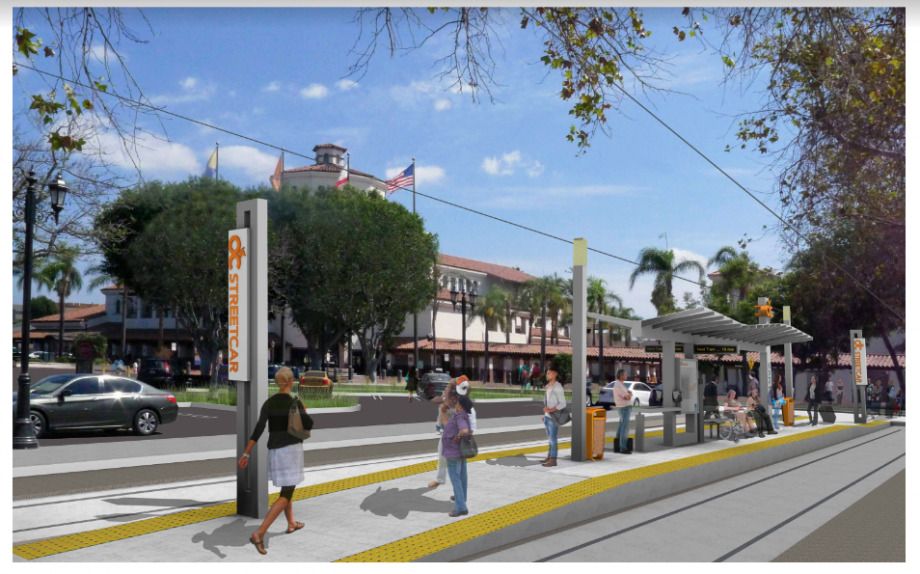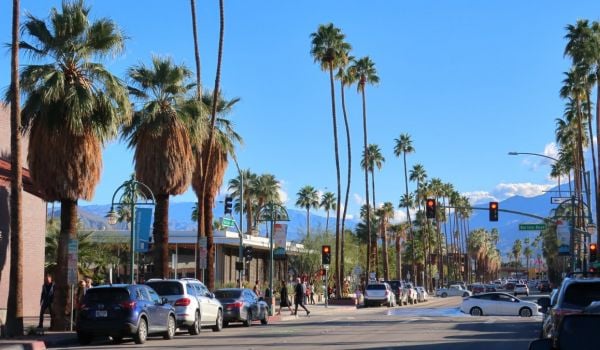Along Santa Ana Boulevard, paleteros push ice cream carts, residents water their yards and women carry loads of clean clothes from the neighborhood laundromat.
Residents go about their days as construction crews work on sewer installations. Orange cones and signs announce street closures.
Crews are making way for a streetcar that will soon travel through this Orange County neighborhood — known as Artesia Pilar in the city of Santa Ana — and carry passengers along a 4.1-mile route that will link the city to bordering Garden Grove. It will be the first modern streetcar in the county.
Transportation officials say the $408 million project, expected to be in operation by 2022, will help passengers get to their final destination after getting off a train. It will connect the Santa Ana Regional Transportation Center to the downtown area and link up with a new transportation center in Garden Grove.
Downtown stakeholders say it will spur economic development in the area. City leaders believe it will improve the quality of life for carless commuters. Some community organizers, however, worry property values around the neighborhood may rise and could displace longtime residents. Research shows gentrification tends to happen in neighborhoods with transit systems.
This can be concerning because the Orange County Transportation Authority — the lead agency behind the project — has not implemented equity guidelines that would address displacement issues. A 2016 UC Berkeley study found that Orange County has the greatest share of neighborhoods considered “disadvantaged” or susceptible to gentrification when compared to Los Angeles and San Diego counties.
Kris Fortin, a member of Santa Ana Active Streets, says the group is worried about the lack of work the OCTA has done around displacement factors and concerns. A 2015 National Institute for Transportation and Communities report found that rents for offices, retail stores and apartments were higher when closer to streetcar systems. Fortin says OCTA community outreach has mainly focused on streetcar designs.
“On matters concerning displacement or impact, it has not been something that has been addressed,” says Fortin.
Eric Carpenter, a spokesman for the OCTA, says that on some matters of equity, the agency’s hands are tied. Land-use decisions are made by the county and individual cities. Both the cities of Garden Grove and Santa Ana signed off on the project. In Santa Ana, the City Council endorsed the streetcar despite initial concerns the project would cause resident displacement. Some downtown merchants early on also worried that traditional festivals including Cinco de Mayo, Fiestas Patrias, and the annual Day of the Dead event would be lost with the addition of the streetcar. City leaders assured residents that would not happen.
Following those clearances at the city level, OCTA is now leading the construction of the streetcar “because of our experience in implementing transit projects,” Carpenter says.
Garden Grove and Santa Ana officials did not return calls for comment on whether they had equity guidelines in place.
Fortin says even though the OCTA doesn’t make land use decisions, it can still implement frameworks to mitigate potential impacts. He referenced OCTA’s Master Plan of Arterial Highways, a plan that’s continuously updated to reflect changing development and traffic patterns.
“They have plans in place that dictate how things happen,” Fortin says. “The Master Plan of Arterial Highways, that’s one of the core documents of why the wide roads are the way they are.”
Across the nation, however, cities and transit agencies are beginning to address these issues of equity and displacement.
In Los Angeles, the Metro board in 2018 approved an equity platform framework acknowledging that “inequity exists and has been largely defined by race and class.” It commits the agency to hosting forums to engage underserved communities and to incorporate equity into its long- range transportation planning.
The city of Los Angeles, in 2017, launched the Transit Oriented Communities program that allows for larger-scale projects near transit if developers keep some units affordable. This program was made possible through a 2016 ballot initiative.
Seattle in 2017, through voter-approved sales tax and vehicle license fee increases, established a Transportation Equity Program that allows for $2 million annually to be used toward improving transit service for low-income riders.
It’s different in Orange County.
“Because we (OCTA) don’t own any land for housing or commercial development, our board of directors wouldn’t have any related policies,” Carpenter says.
“That makes OCTA different and difficult to compare with Metro in L.A. or other agencies that may control land-use and development around transit projects,” he adds.
Organizers with Santa Ana Active Streets, however, say Orange County transportation officials have been tone-deaf when it comes to issues over equity.
At the 2016 Orange County Active Transportation Forum — an annual gathering for Orange County transit advocates — Santa Ana Active Streets member Marina Ramirez asked a panel of speakers what was being done to address displacement from transportation improvements. She also wanted to know if the agency had an equity policy.
Darrell Johnson, OCTA’s chief executive officer, answered. He said the term equity could mean different things, according to a Streetsblog article written by Fortin. The way Johnson saw it, Fortin wrote, residents in South Orange County may feel they’re not treated equally because millions of dollars were invested for a streetcar in the northern side of the county. Johnson was also quoted saying property values will change regardless of new transit projects.
“I think the urbanization of our county is changing regardless of whether there’s a streetcar project there or not,” he was quoted as saying in the article. “Those issues around property valuations, and property taxes, those are going to be there regardless. This may accelerate it in some way, but it’s going to occur no matter what.”
To Fortin, it’s irresponsible to compare North and South Orange County because there are stark racial and class between those regions.
Most people of color live in the lower income areas of North and Central Orange County which includes the cities of Santa Ana and Garden Grove, according to a 2014 report by UC Irvine and UCLA. Majority white communities live in South Orange County and along the beaches, according to the report. Additionally, home ownership rates were lower in cities like Santa Ana when compared to South Orange County cities like Laguna Niguel.
Although some residents have voiced streetcar concerns at community meetings, there has not been much backlash against the project.
“One of our biggest difficulties is getting people to understand all different levels of getting a project done and its impacts,” Fortin says. “It’s a project that’s hard to understand for people because it’s never been done.”
Carpenter, with OCTA, says the streetcar will be an asset to the dense city of Santa Ana that has more than 300,000 residents. It will not only connect to Metrolink commuter rail but to more than a dozen of OCTA’s busiest bus routes along the way, Carpenter says. Streetcar rates are expected to cost around the same as a bus ride, which is $2 per ride and $5 for a day pass. This will give people “another important public transit option,” Carpenter says.
But to Adonia Lugo, an urban anthropologist and mobility justice strategist, streetcars are simply outdated.
Lugo has lived in cities with streetcars like Portland, Seattle and Washington, D.C., and “in none of those cities was a streetcar actually something that was considered a viable transportation option by local residents,” she says.
To Lugo, this kind of transportation system is more for tourists or for the “look of a district.”
“If OCTA decided that a streetcar was the way they needed to go, it really seems like that’s more about trying to attract certain kinds of users than it is about ensuring the people who already live in those areas and are already using transit are having better access.”

Alejandra Molina is a Next City Equitable Cities Fellow for 2018-2019. Previously, she was a reporter for the Southern California News Group where she covered cities, immigration, race, and religion. In her decade-long career, she's reported how gentrification has affected downtown Santa Ana in Orange County, followed up how violent shootings have affected families and neighborhoods, and reported how President Donald Trump has impacted undocumented communities in the Inland Empire. Her work has appeared in The Press-Enterprise in Riverside, The Orange County Register, The Los Angeles Daily News, and The Mercury News in San Jose. She graduated with a bachelor’s degree in broadcast journalism from the University of La Verne, where she taught an introductory journalism course as an adjunct professor.
















